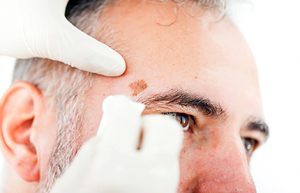Skin lightener containing mercury can cause serious health problems

You can protect your health and your skin by asking your dermatologist to recommend a skin lightener.
A skin lightener can fade — or even clear — dark spots and patches on your skin, but some come with serious health risks.
If your skin lightener contains mercury, it could be damaging your kidneys without you knowing it. Mercury can also injure your nerves, leading to permanent numbness or tingling in your hands, feet, or around your mouth.
If your children snuggle up against you, the mercury could harm their developing brains.
Your husband can also develop serious health problems if your skin-lightening product contains mercury. He could develop mercury poisoning, which can cause irritability, shyness, and tremors. Mercury poisoning can also lead to problems with eyesight, hearing, or both.

Are there any warning signs that you’re putting mercury on your skin?
Sometimes. Your skin may feel rough and dry where your applied the skin lightener. Your skin may itch. You may feel tired, weak, or have muscle pains. Some people have a metallic taste in their mouths.
If you’re using a mercury-laden skin lightener, the product may cause skin rashes, scars, discolored skin, anxiety, or depression.
Can you tell if a skin lightener contains mercury before you use it?
Sometimes it’s possible — but not always. Here are 3 things you can do.
1. Look at the list of ingredients. According to the World Health Organization (WHO), a product contains mercury if you see one of more of these ingredients:
- Calomel
- Cinnabaris
- Hydrargyri oxydum rubrum
- Quicksilver
If you see the word “mercury” or “mercuric” on the list of ingredients that also means the product contains mercury. For example, you might see mercuric amidochloride, mercury oxide, or mercury salts.
2. Check for a warning that tells you to keep the product away from silver, gold, rubber, aluminum, and jewelry. Mercury can damage these.
3. Peek at the color if you can. A product that contains a lot of mercury is often gray or cream colored. It’s important to keep in mind, though, that a product can be gray or cream-colored without containing mercury.
Because many countries have laws that prohibit mercury in skin care products, it’s possible that you won’t find any of these clues.
Do skin lighteners sold in the United States contain mercury?
Studies show that you can easily buy a mercury-laden skin lightener in the United States. In one study, scientists in the United States set out to buy every skin-lightening product they could find.

The scientists bought products online from countries around the world. They also scoured the shelves of U.S. stores, looking for skin lighteners. They found skin lighteners at beauty supply shops, department stores, ethnic groceries, and other retailers located within four of the largest US. metro areas — New York City, Los Angeles, Chicago, and Phoenix.
Anything that promised to lighten the skin — from creams to soaps — they bought. After their shopping spree, they had 549 different products. They tested each for mercury.
Nearly 12% of the skin lighteners contained mercury. About half of these products came from U.S. stores.
Why do some skin lighteners contain mercury?
While mercury can be harmful to your health, it also can effectively remove dark spots and lighten your skin tone. Mercury is also an inexpensive skin-lightening ingredient.
How can I find a safe skin lightener?
To protect your health and get the results you seek, the AAD recommends seeing a board-certified dermatologist. The advantages of seeing a dermatologist include that you can:
- Learn what can lighten your skin. A skin lightener cannot always get rid of patches of darker skin. For example, if you have melasma that sits deep in your skin, you may need a chemical peel or laser treatment.After examining your skin and learning about what you want to do, a dermatologist can tell you what may help.
- Make sure you get a trustworthy skin-lightening product. A dermatologist can recommend a product that will lighten your skin or fade dark spots without using mercury.This will also help you avoid other harmful ingredients. Some skin lighteners that you can buy contain strong steroids. If you use this product for several weeks or months, you can damage your skin.
- Find skin cancer. A dermatologist should check your skin for signs of skin cancer before you start using a skin lightener. Sometimes, skin cancer looks like an age spot or dark patch on your skin.
- Get a treatment plan that can help fade dark spots and prevent them from returning. Most dark spots and patches are caused by sunlight. If you treat your skin and continue to go outdoors without sun protection, you’ll have to treat your skin all the time to fade the dark spots and patches.A dermatologist can show you how to protect your skin from the sun so that you do not develop more dark spots and patches. This can save you money.A dermatologist will also try to recommend products within your budget.
Why put your health at risk? Make an appointment with a board-certified dermatologist and see what’s possible.
Images
Images 1, 2: Getty Images Image 3: Property of the American Academy of Dermatology
References
Hamann CR, Boonchai W, et al. “Spectrometric analysis of mercury content in 549 skin-lightening products: Is mercury toxicity a hidden global health hazard?” J Am Acad Dermatol 2014;70:281-7.
U.S. Food and Drug Administration. “Mercury poisoning linked to skin products.” Updated July 26, 2016. Last accessed November 10, 2017.
World Health Organization. “Mercury in skin lightening products.” 2011.
© 2025 American Academy of Dermatology. All rights reserved. Reproduction or republication strictly prohibited without prior written permission. Use of these materials is subject to the legal notice and terms of use located at https://www.aad.org/about/legal
